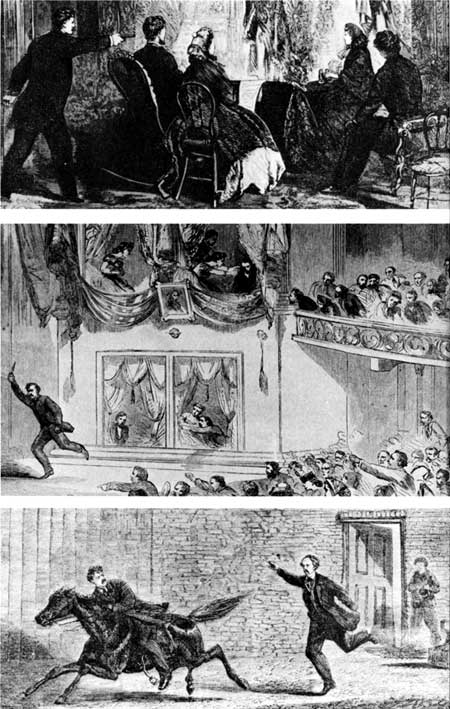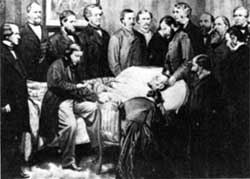|
FORD'S THEATRE National Historic Site |
 |

ASSASSINATION AND DEATH OF LINCOLN
President Lincoln was leaning slightly forward with his hand on the balustrade and had turned his head to look into the audience. Pulling around the flag that decorated the box, he was looking between the pillar and the flag. It was at this moment, approximately 10:15 p.m., that Booth silently entered the door to box 8 and fired the fatal shot. A single-shot, muzzle-loading Deringer, about 6 inches long, was fired by the assassin at close range. The bullet, less than one- half inch in diameter, entered slightly above and between his left ear and the median of the back of his head, and lodged close behind the right eye. The President slumped forward in his chair, and then backward, never to regain consciousness.
Instantly, Major Rathbone sprang upon the assassin. Booth dropped the Deringer, broke from Rathbone's grasp, and lunged at him with a large knife. Rathbone parried the blow, but received a deep wound in his left arm above the elbow. Booth placed one hand on the balustrade, to the left of the center pillar, raised his other arm to strike at the advancing Rathbone, and vaulted over the railing. Rathbone again seized Booth but only caught his clothing. As he leaped, Booth's right boot struck the framed engraving of Washington, turning it completely over. The spur on his right heel caught in the fringe of the Treasury Guards' flag and brought it down, tearing a strip with it. These obstacles caused the assassin to lose his balance and he fell awkwardly on the stage, at least 11-1/2 feet below, tearing a rent in the green baize carpet. He landed in a kneeling position, with his left leg resting on the stage. In the fall, the large bone of his left leg was fractured about 2 inches above the ankle.
The actor regained his feet with the agility of an athlete, and is asserted to have flourished his dagger and shouted "Sic Semper Tyrannis" (Thus always with tyrants), the motto of the Commonwealth of Virginia, before dashing across the stage. Harry Hawk, seeing Booth striding toward him with a knife, ran through the center doorway on the stage and up a flight of stairs to the flies.
Leaving the stage on the north side of the theatre, Booth passed between Laura Keene and young William J. Ferguson, standing near the promptor's desk. In the narrow aisle leading from the stage to the rear door, Booth bumped into William Withers, Jr., the orchestra leader. He slashed twice at Withers, cutting his coat and knocking him to the floor before rushing out the door. Grasping the reins from "Peanuts" Burroughs, the assassin felled him with the butt end of his knife, then mounted his horse and rode swiftly from the alley.
Maj. Joseph B. Stewart, a lawyer, who was 6 feet 6 inches tall and probably the tallest man in Washington, was sitting in the front seat of the orchestra, on the right-hand side. Startled by the shot, he looked up and saw Booth tumbling onto the stage. Rising instantly. Stewart climbed over the orchestra pit and footlights, and pursued Booth across the stage, shouting several times "Stop that man!" He stepped out the back door only to see Booth mount his horse and ride away.
The audience, not realizing what had happened, was stunned for a moment by the report of the pistol. Even when Booth was seen leaping from the box to the stage, many thought it all a part of the play. The screams of Mrs. Lincoln first disclosed that the President was shot. Ford's Theatre then became a scene of terror and pandemonium. The people left their seats and wandered about in wild confusion. When the audience was quieted, the theatre was vacated.

|
Several doctors attended the stricken President. Asst. Surg. (U.S.A.) Charles A. Leale, seated in the nearby dress circle, was the first to reach the box, and Asst. Surg. Charles S. Taft was lifted from the stage into the box. Dr. A. F. A. King, of Washington, was also present. Examining the wound, they ordered the body of Lincoln to be removed to the nearest bed, as the ride over the rough cobblestone pavement to the Executive Mansion would have brought on a fatal hemorrhage. The unconscious form was carried down the dress circle stairway. On reaching the street, a man was seen on the porch of a house opposite, in front of a lighted hallway. The surgeons ordered Lincoln to be brought into this house. He was carried up the curving steps and down a hall to a small, first-floor bedroom. The single bed was pulled out from the corner of the room and the dying President laid diagonally across it, his extreme height not permitting any other position.
Throughout the night Cabinet members, physicians, and distinguished men watched at Lincoln's bedside. All of the Cabinet officers were there, except Secretary of State William H. Seward. At least six doctors were also in the room. Surg. Gen. Joseph K. Barnes and Dr. Robert K. Stone, the family physician, probed the wound and found it to be mortal.
Assisted by Major Rathbone, Miss Harris, and Laura Keene, Mrs. Lincoln followed her husband across to the Petersen House. Major Rathbone collapsed from loss of blood and was taken home. Mrs. Lincoln occupied the front parlor and here was secluded from the curious. Going to Lincoln's bedside from time to time, her anguish and grief increased with each view of her dying husband. Sometime before his death, his labored breathing and change of countenance so affected her that she fell in a faint so prolonged that a physician ordered that she not be permitted again to enter the room.
In the back parlor, members of the Cabinet conferred, and here Secretary of War Stanton began his investigation of the assassination and interviewed witnesses of the tragedy. Vice President Andrew Johnson visited the President's bedside during the night but departed before the end.
About 7 o'clock in the morning, April 15, 1865, Dr. Stone announced that death was near, and at 7:22 a.m. the President died. The Reverend Phincas D. Gurley, pastor of the New York Avenue Presbyterian Church, offered a prayer and Secretary of War Edwin M. Stanton approached the bed and is said to have uttered the enduring words 'Now he belongs to the ages."
At about 10 p.m. on April 14, 1865, at almost the same time that Booth assassinated President Lincoln, Lewis Paine entered the residence of Secretary of State Seward, Madison Place, Lafayette Square, on the pretext of delivering medicine to Seward, who had been injured in a carriage accident. Paine fractured the skull of Frederick Seward, a son of the Secretary, with his revolver, slashed a male nurse, and stabbed Seward twice in the face. Only the fact that he was wearing a steel brace around his neck and broken jaw saved Seward's life.
On April 18, 1 865, thousands of people viewed the remains of President Lincoln in the East Room of the Executive Mansion. Funeral services were held in this room on April 19, and then the coffin headed a procession which moved down Pennsylvania Avenue to the Capitol. Placed in the rotunda of the Capitol, the bier was visited by huge throngs on April 20.
The train bearing the coffin left for Springfield, Ill., on April 21, following in reverse almost the same route taken by Lincoln in reaching Washington early in 1861. His body was placed in state in several of the large cities en route. On May 4, the coffin was placed in the receiving vault of Oak Ridge Cemetery, Springfield, Ill., 15 days after the services at the Executive Mansion in Washington. The Lincoln Monument, located on the hill above the receiving vault, was dedicated on October 15, 1874. It contains the bodies of President and Mrs. Lincoln and three of their four sons, Edward, William, and Thomas (Tad). The eldest, Robert Todd, the only Lincoln son to reach maturity, is buried in Arlington National Cemetery.

|

| History | Links to the Past | National Park Service | Search | Contact |
|
Last Modified: Mon, Dec 2 2002 10:00:00 am PDT |

